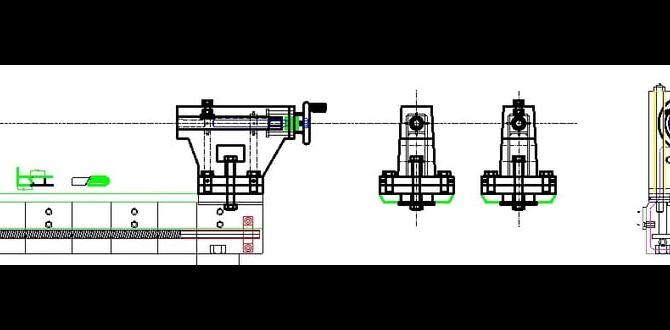Quick Summary: An 1/8″ carbide end mill is a precision cutting tool, excellent for intricate milling in forged steel up to HRC60. Its small size and tough carbide construction make it ideal for detailed work, like creating small features and engraving, ensuring a mirror finish when used correctly. It’s a go-to for fine detail in metal machining.
Hey folks, Daniel Bates here from Lathe Hub! Ever stared at a piece of forged steel, dreaming of carving intricate details, only to be held back by the right cutting tool? I know the feeling. Sometimes, even a small project demands a tool that’s both incredibly tough and remarkably precise. That’s where the humble 1/8″ carbide end mill shines, especially when you’re working with hardened steel.
Many beginners get a bit intimidated by these tiny, yet powerful, tools. They look delicate, and the thought of using them on hard metals can seem daunting. But trust me, with the right knowledge and a few simple tips, a 1/8″ carbide end mill can become your best friend for detailed metalwork. It’s the secret weapon for those delicate engravings, small slots, or tiny pockets that larger tools just can’t handle.
We’ll be diving deep into why the 1/8″ carbide end mill is such a crucial piece of kit for anyone working with forged steel. We’ll cover what makes it special, how to choose the right one, and most importantly, how to use it safely and effectively to achieve that beautiful mirror finish.
Ready to unlock some serious detail in your projects? Let’s get started and demystify this fantastic little tool!
Why the 1/8″ Carbide End Mill is a Machinists’ Essential for Forged Steel
When you’re faced with a project that requires precision on hardened steel – think up to HRC60 – you need a cutting tool that can handle the challenge without chattering or breaking. This is where the 1/8″ carbide end mill truly earns its keep. Its small diameter allows for incredibly fine detail work, while the carbide material provides the hardness and heat resistance necessary for cutting tough metals.
Let’s break down what makes this specific tool so valuable:
- Precision & Detail: The 1/8″ (which is approximately 3.175mm) size is perfect for creating super-fine slots, intricate engravings, small chamfers, and precise pockets that are often impossible with larger end mills.
- Hardness & Durability: Carbide (specifically Tungsten Carbide) is significantly harder than high-speed steel (HSS). This means it can cut harder materials like forged steel (up to HRC60) and lasts much longer under demanding conditions. It also resists heat better, which is crucial for high-speed cutting.
- Mirror Finish Potential: High-quality carbide end mills, especially those designed for finishing with more flutes (like 4 or 6), are capable of producing a remarkably smooth, almost mirror-like surface finish. This is essential for aesthetic parts or components that require tight tolerances.
- Versatility: While we’re focusing on forged steel, these end mills can also be used on other metals and even some harder plastics, making them a versatile addition to your tool collection.
Understanding the “Carbide End Mill 1/8 inch 8mm Shank Extra Long for Hardened Steel HRC60 Mirror Finish”
That’s a mouthful of keywords, but each part tells us something critical about the tool and its intended use. Let’s unpack it:
- Carbide End Mill: As we discussed, this tells us the material – it’s made of tungsten carbide, known for its hardness and wear resistance.
- 1/8 inch: This is the cutting diameter. Essential for knowing how wide of a slot or how small of a feature you can create.
- 8mm Shank: This refers to the diameter of the part of the end mill that goes into your milling machine’s collet or tool holder. An 8mm shank is a common metric size. This is important for ensuring compatibility with your machine’s tooling.
- Extra Long: This indicates the tool has a longer flute length and/or overall length than a standard end mill. This is useful for reaching into deeper cavities or working on parts with specific geometries. However, “extra long” tools can be more prone to vibration and deflection, so careful setup and slower speeds are often needed.
- For Hardened Steel (HRC60): This is a key specification. It means the end mill is designed and manufactured to cut steel that has been heat-treated to a hardness of Rockwell 60. This is quite hard, requiring specific geometries and coatings on the end mill.
- Mirror Finish: This designation implies the end mill has a highly polished flute geometry and is designed for finishing passes, where the goal is a smooth, reflective surface rather than just material removal.
So, when you see this full description, you know you’re looking at a specialized tool for demanding, high-precision finishing work on very hard steels.
Types of 1/8″ Carbide End Mills for Forged Steel
Not all 1/8″ carbide end mills are created equal, especially when you’re aiming for a mirror finish on hardened steel. Here are the common types you’ll encounter, and how they differ:
By Number of Flutes:
Flutes are the helical grooves that run up the cutting edges of the end mill. They carry away chips and influence cutting action.
- 2-Flute: Excellent for general cutting, especially in aluminum and softer materials, due to better chip clearance. For hardened steel, they can work but might not offer the best finish.
- 3-Flute: A good balance between chip clearance and cutting rigidity. Can be used for both slotting and some finishing.
- 4-Flute (or more): Generally preferred for finishing harder materials like steel. The increased number of flutes provides a smoother cutting action and better surface finish. They have less chip clearance, so they are often used in lighter cuts for finishing or in materials that don’t produce long, stringy chips. For achieving a mirror finish on HRC60 steel, a 4-flute (or even a 6-flute) dedicated finishing end mill is often the best choice.
By Coating:
Coatings add another layer of performance, increasing hardness, reducing friction, and improving heat resistance.
- Uncoated: A bright, polished carbide. Works well in softer applications or with excellent lubrication. For hardened steel, coatings are usually recommended.
- TiN (Titanium Nitride): A common, general-purpose coating. Adds some hardness and lubricity, extending tool life compared to uncoated. Good for medium-duty steel cutting.
- AlTiN (Aluminum Titanium Nitride): A superior coating for high-temperature applications and hardened steels. It forms a protective oxide layer at high temperatures, allowing you to run faster speeds and feeds while maintaining tool life. This is often the go-to for cutting HRC60 steel.
- ZrN (Zirconium Nitride): Provides good lubricity and is often used for finishing aluminum, but can also be beneficial in steels for a good surface finish.
- DLC (Diamond-Like Carbon): An extremely hard and low-friction coating, excellent for abrasive materials and achieving superior finishes. Often found on premium finishing end mills.
By Geometry:
- Square End: The most common type, creating flat-bottomed slots and pockets.
- Ball Nose: Features a rounded tip, ideal for creating contoured surfaces, fillets, and 3D shapes.
- Corner Radius: A compromise, featuring a square tip with a small radius ground into the corners. This strengthens the cutting edge and prevents sharp corners from chipping, while still allowing for relatively flat-bottomed features. Useful for tougher materials.
For the specific keyword phrase “Carbide End Mill 1/8 inch 8mm Shank Extra Long for Hardened Steel HRC60 Mirror Finish,” you are most likely looking for a 4-flute (or more) coated (likely AlTiN or DLC) square or corner radius end mill with an extended reach.
Choosing the Right 1/8″ Carbide End Mill
Selecting the correct 1/8″ carbide end mill is crucial for success, especially when working with tough materials and aiming for a high-quality finish. Don’t just grab the first one you see! Consider these factors:
Key Specifications to Look For:
- Material: Always choose Solid Carbide (or Tungsten Carbide) for machining hardened steel.
- Diameter: You need a 1/8″ (0.125″) cutting diameter.
- Shank Diameter: For this specific keyword, it’s specified as 8mm. Ensure your collets or tool holders can accommodate this. Common imperial sizes are 1/8″, 1/4″, 3/8″, etc., and metric are 3mm, 6mm, 8mm, 12mm.
- Length: The “Extra Long” specification is important. Measure the depth you need to reach in your part. Standard lengths might not be sufficient. Be mindful that longer tools can be less rigid.
- Number of Flutes: For hardened steel and mirror finishes, aim for 4 or more flutes. If chip evacuation is a significant concern in a deep slot, a 2-flute might be considered, but expect to adjust speeds/feeds and potentially make multiple passes.
- Coating: For HRC60 steel, an AlTiN or similar high-performance coating is highly recommended for heat resistance and extended tool life.
- End Type: Square for flat bottoms, Corner Radius for edge strength and to prevent chipping, Ball Nose for 3D contours. For general-purpose milling of hardened steel features, a corner radius can offer better durability than a sharp square corner.
- Helix Angle: Common helix angles are 30°, 45°, and 90°. A higher helix angle (like 45°) generally provides a smoother cut. A 0° or 90° helix is often called a “straight flute” or “form-relieved” end mill, typically used for slots or where chip evacuation is paramount. For finishing hardened steel, a standard moderate helix is usually best.
Where to Buy:
Reputable tool suppliers are your best bet. Look for well-known brands in the machining industry. Some great places to start your search include:
- Online Machine Tool Suppliers: Websites like MSC Industrial Supply, Grainger, McMaster-Carr, and many specialized carbide tooling manufacturers offer a vast selection.
- Specialty Carbide Tooling Companies: Many companies focus specifically on end mills. Searching for “carbide end mill manufacturers” can lead you to them.
- Hobby Machine Shops: Some online retailers cater specifically to the hobbyist and home shop market, offering quality tools at competitive prices.
Always check product descriptions carefully to ensure you’re getting the exact specifications you need. Often, you’ll find detailed spec sheets available.
Essential Safety Practices
Working with milling machines and sharp tools like end mills demands respect for safety. A broken end mill can fly with incredible force. Always follow these paramount rules:
- Wear Safety Glasses: Always, no exceptions. If possible, use a full face shield over your safety glasses.
- Secure Your Workpiece: Ensure your part is firmly clamped in a vise or held securely. A moving workpiece is extremely dangerous.
- Use the Right Tooling: Make sure the end mill is properly seated in a good quality collet or tool holder and that the shank is within the pull-out length of the collet. Avoid using set screws on tool holders if possible, as they can damage the shank and cause runout.
- Proper Feed Rates & Speeds: Consult manufacturer recommendations or online calculators. Too fast can lead to tool breakage; too slow can lead to poor finish or work hardening.
- Chip Evacuation: Ensure chips can escape the cutting area. If they build up, they can cause tool wear and breakage. Use compressed air or coolant if necessary.
- Never Reach Over a Running Machine: Keep hands and clothing away from moving parts.
- Emergency Stop: Know where your machine’s emergency stop button is and don’t hesitate to use it.
- Tool Inspection: Before each use, visually inspect the end mill for any signs of wear, chipping, or damage. Discard dull or damaged tools immediately.
A good resource for machining safety guidelines is the Occupational Safety and Health Administration (OSHA), which provides numerous standards and recommendations for safe machining practices.
Setting Up Your 1/8″ Carbide End Mill for Success
Proper setup is half the battle when milling hardened steel. A small tool like an 1/8″ end mill requires meticulous attention to detail.
1. Collet Selection and Installation:
For a 1/8″ end mill and an 8mm shank, you’ll need an 8mm collet. Ensure the collet is clean, free of debris, and the end mill is inserted to the correct depth – typically at least 2-3 times the shank diameter to ensure rigidity. A well-fitted collet is essential for minimizing runout (wobble).
2. Tool Length Measurement:
Accurate Z-axis measurement is critical. Use a tool setter, edge finder, or a simple piece of paper (for a rough zero) to find the top of your workpiece. For precise repeatability, an electronic tool presetter or a touch probe is ideal.
3. Machine Rigidity:
Ensure your milling machine is stable and free of excessive vibration. Any looseness in the ways, spindle, or table will be amplified by a small, rigid carbide tool, leading to poor finish and potential breakage.
4. Coolant/Lubrication:
For hardened steel, coolant or a flood lubrication system is highly recommended. It helps to dissipate heat, prolong tool life, and improve surface finish. If flood coolant isn’t available, a high-quality cutting fluid applied directly to the cutting zone is a must.
5. Speeds and Feeds:
This is crucial and often requires some research or experimentation. Carbide manufacturers provide recommended starting points. For a 1/8″ carbide end mill on HRC60 steel, speeds will be lower than for softer materials, and feed rates must be precise.
A common starting point for surface speed (SFM) for carbide in hardened steel might be between 50-150 SFM. To calculate RPM:
RPM = (SFM 3.82) / Diameter (inches)
RPM = (e.g., 100 SFM 3.82) / 0.125 inches = 3056 RPM
Feed per tooth (IPT) will be very small, often in the range of 0.0005″ to 0.0015″.
Feed Rate (IPM) = RPM IPT Number of Flutes
Feed Rate (IPM) = 3056 0.001 4 = 12.2 IPM
These are starting points. You will likely need to adjust based on your machine’s condition, the specific steel alloy, and the coating of your end mill. Listen to the cut – a smooth, consistent sound is good; chattering or screaming indicates a problem.
Step-by-Step Guide: Milling Forged Steel with a 1/8″ Carbide End Mill
Let’s walk through a typical milling operation. We’ll assume you want to mill a precisely sized slot or pocket.
Step 1: Preparation
- Machine Check: Ensure your milling machine is clean, lubricated, and all gibs are set appropriately for rigidity.
- Workpiece Setup: Securely clamp your forged steel workpiece in the vise. Ensure the vise’s hardened jaws are good quality.
- Tool Installation: Insert the 1/8″ 8mm shank carbide end mill into the appropriate 8mm collet. Tighten the collet securely in the spindle.
- Coolant: Turn on your coolant system or have your cutting fluid ready.
Step 2: Setting Z-Axis Zero
- Lower the spindle until the tip of the end mill is close to the top surface of your workpiece.
- Use your preferred method (tool setter, edge finder, paper method) to accurately set your Z-axis zero point. For precise work, an electronic tool setter is recommended.
Step 3: Setting X and Y-Axis Zero
- Use an edge finder, center finder, or probe to find the center or edge of your workpiece where you want to start your cut.
- Set your desired X and Y coordinates accordingly.





